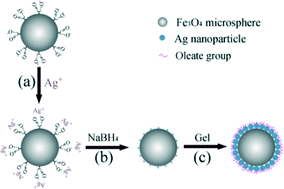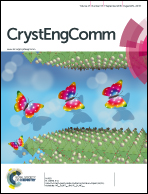Gel-assisted synthesis of oleate-modified Fe3O4@Ag composite microspheres as magnetic SERS probe for thiram detection†
Abstract
Fast detection and identification of thiram, a kind of well-known pesticide, presents a great challenge to environmental researchers. This work developed a kind of oleate-modified Fe3O4@Ag core@shell composite microsphere as a magnetic separable SERS substrate for quick selective sensing of thiram. In the synthesis procedure, the bulk gel containing oleate was used as the reaction system, which not only avoided the aggregation of Fe3O4 microspheres by fixing them during silver coating, but also modified the silver shell with oleate groups simultaneously. Through serial experiments, the silver seeds on the surface of the Fe3O4 microspheres were found to influence the shell growth strongly, and the Fe3O4@Ag core@shell composite microspheres could only be obtained when the Fe3O4 microspheres with dense silver seeds were used as the template. The surface capped oleate groups and the inner magnetic core made the as-obtained Fe3O4@Ag core shell composite microsphere a highly efficient SERS substrate for fast and selective monitoring of thiram in solution, and the well-coated Fe3O4@Ag core@shell composite microspheres exhibited excellent selective probing performance for thiram with a detection limit as low as 10−8 M.


 Please wait while we load your content...
Please wait while we load your content...